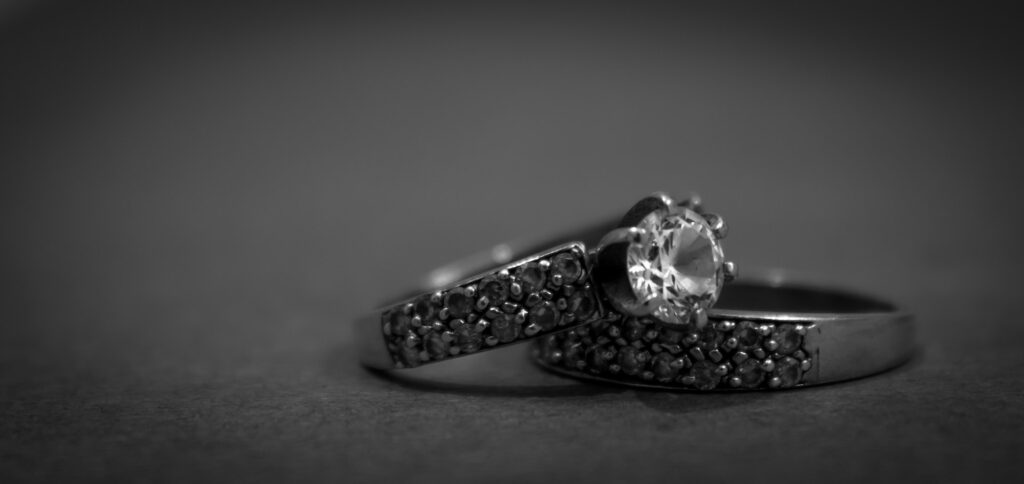Many of us have gotten our rings resized at some point in life, whether it be because we got the wrong size, gained or lost weight, or simply because we chose to wear the ring on a different finger. And while most of the time the resizing process is smooth, it can sometimes yield unforeseen results such as, well, the ring looking different after resizing.
Read my complete guide if you think your stone, specifically, looks different after resizing.
If you find yourself in this dilemma, here is a list of the possible problems, their causes and fixes to help you navigate the situation. Here are some possibilities:
The Ring Looks Oval Instead Of Round
Sometimes, the ring can appear to be distorted into an oval shape instead of round after size alteration. This occurs primarily when the size is decreased, specifically of a ring that has stones on the top part.
This happens when the jeweler is afraid of curving the top part of the ring, the one holding the prongs with the stones, as it can alter the tension that is holding the stones firmly and risk them falling out. Thus, only the bottom part of the ring is altered which can make the ring oval shaped instead of a perfect round.
This distortion is almost always benign and subtle, and does not essentially need to be fixed. However, if you want your ring to be completely round, this goal can be achieved by taking it to an experienced jeweler who will re-round the ring and tighten the prongs to make sure the stones are secure.

The Bottom Part Of The Band Looks Thinner
Although it is not very common, sometimes the resizing and polishing process can result in the bottom part of the band becoming tapered.
This happens when the jeweler attempts to make the ring round shaped again after removing or adding metal to it during the resizing process. Alternatively, it can also happen during a rigorous polishing session.
If you are worried that this might decrease the value of the ring, you should definitely check out my article “Does Resizing a Ring Devalue It?” where I discuss the subject in detail.
Again, this modification rarely presents a problem and is more or less harmless. However, if you are afraid that the band might be weakened by being too thin, this can be fixed by the jeweler by the process of re-shanking. The tapered bottom part is cut away and replaced with a new, custom made metal part of the adequate width. This makes the band uniform in size.
Discoloration At The Joint
It is not uncommon to see clients freaked out because they see an area of discoloration on the ring after getting it resized.
This happens when the soldering alloy – the metal that is used to reunite the band after adding or removing parts of it – is of a different color than the ring itself. It can appear as a thin line or a slightly thicker block, depending on whether the ring was sized up or down.
Although it does not affect the strength of the ring, the difference in color can be unpleasant to look at.
If you are faced with this problem, there is no need to fret. All you have to do is take your ring to the jeweler who will coat or plate the soldering alloy with the same metal as the rest of the ring. This is followed by polishing the ring to make it appear smoother and uniform overall.
Dent/Depression/Nick At The Joint
Another frequent complaint received after getting the ring size altered is the appearance of a nicked line on the band.
This is the site where the ring has been soldered after resizing, and is often a result of poor craftsmanship by an inexperienced jeweler. This is worrisome because the ring can become weak at the spot of the dent and might even break apart under too much pressure.
If you see a nicked line on your ring, it is best to take it to a good jeweler, who will add more metal to the site and polish it to make it look even.
Color Of The Ring Is Changed
Perhaps the most distressing issue a client can face with their ring after getting it resized is seeing it in an entirely different color. While this almost never occurs with rings made of pure metals such as pure gold, it can happen with rings that are plated with a metal.
The intense heat used in the soldering process can cause the plating to oxidize, causing it to change color, most often getting darker.
Additionally, this problem can also occur with rose gold rings. As rose gold is an alloy of gold and copper, the heat oxidizes the copper and causes the ring to appear yellow gold.
If your ring has a plating, this discoloration can be resolved by simply getting a thick layer of metal plating on it. However, if your rose gold ring is discolored to a yellow gold, it can be fixed by getting it polished thoroughly until the real color appears.
Ring Feels Rough/Has Scratches
A fairly common change noticed by clients after getting their ring size altered is that the ring appears rough and has scratches. This has nothing to do with the resizing itself, and is mostly a result of the handling during the process.
Marks on a ring are a fairly common complaint after resizing, so I wrote an entire article titled Does Resizing a Ring Leave a Mark? to deal with subject in greater detail.
Although it makes the ring appear less pleasant and shiny, the scratches do not affect the quality or strength of the ring and can be fixed fairly easily.
All you need is some polishing, and the ring will appear brand new.
Check out some of my other equally helpful ring guides too: